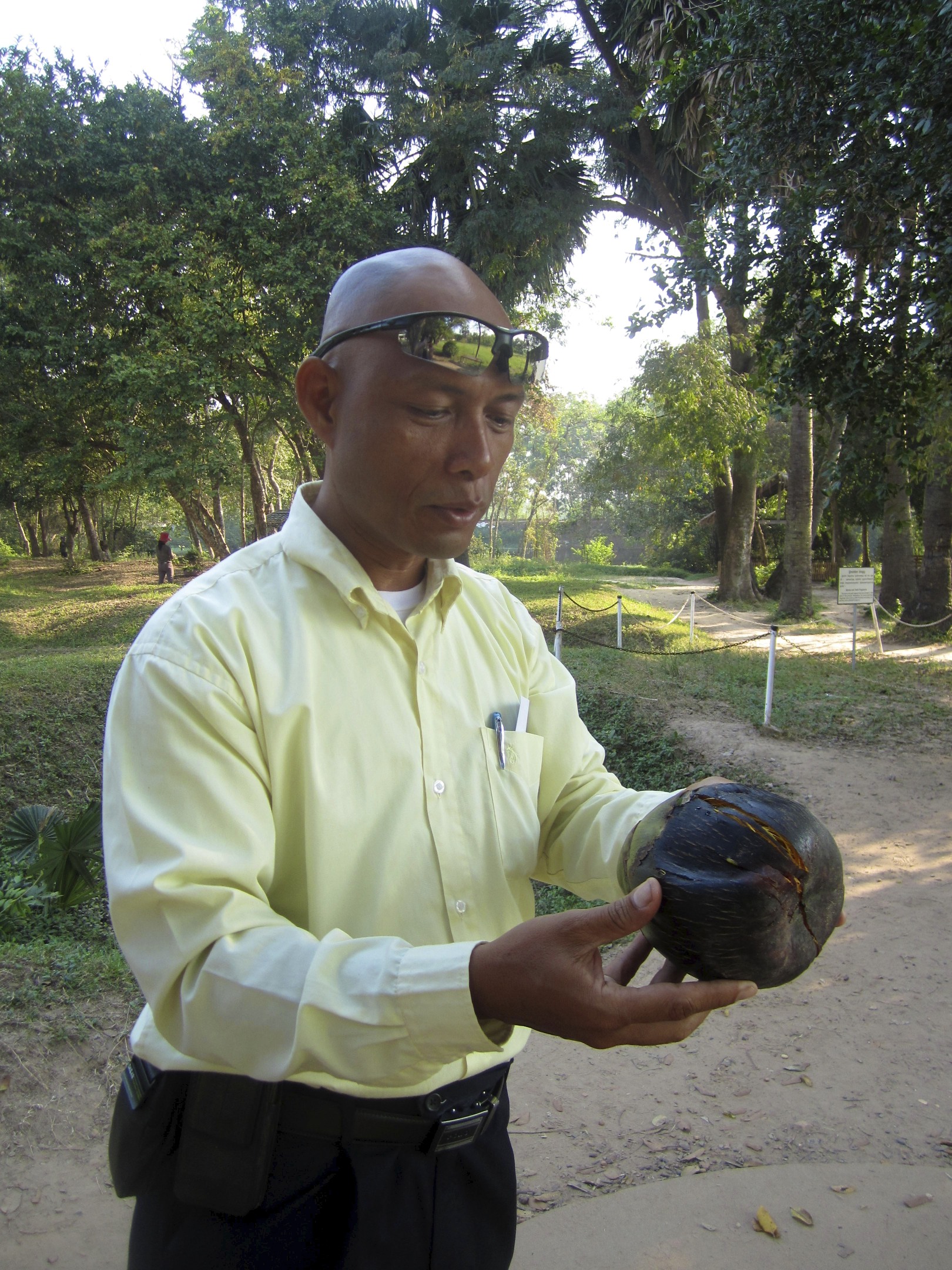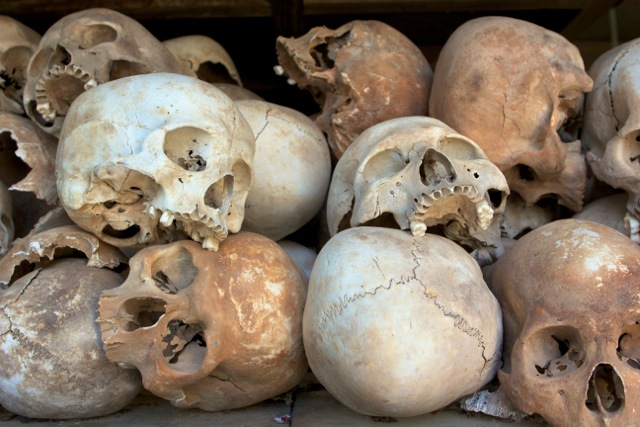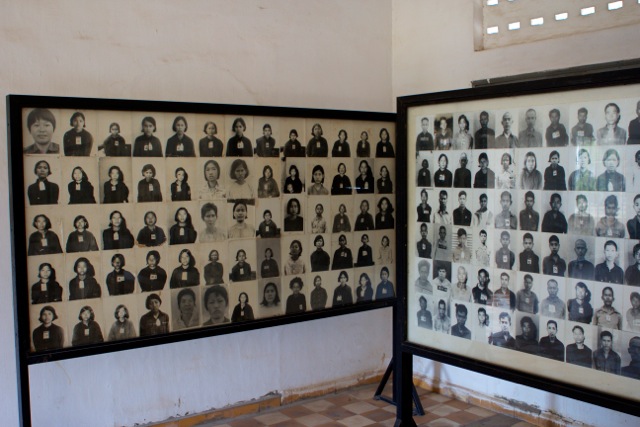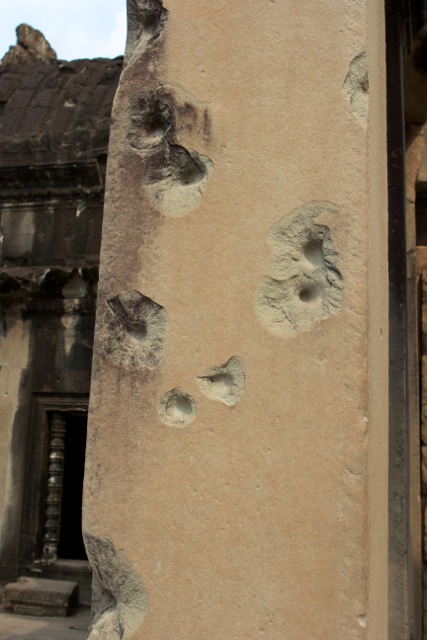We arrived here Saturday full of excitement and anticipation about our visit to Angkor Wat. This is the first trip to Cambodia for either one of us, and the temples of Angkor Wat have ranked fairly high on our “bucket lists”. We were aware of the history of war and terror in Cambodia; however, our two-day stay in Phnom Penh was an eye-opener. Our guide was a gentleman named Rith who shared his personal account of the 70’s and Pol Pot’s reign of terror over the people of Cambodia. At the time, Rith was 7 years old and living in Phnom Penh with his parents, older sister, and three brothers. When Pol Pot seized power in 1975, Rith and his family were separated. Each of his parents and siblings were taken to different camps and villages. Rith was taken to an area near the Ho Chi Minh Trail where he and other young boys worked the fields and hauled supplies and ammunition to the Khmere Rouge soldiers on the front. He lived in the camp for three years, was given a new name, and saw his friends die one-by-one from disease and starvation. He told us that as a child, he believed everything he was told by the Khmere Rouge…..that “Uncle” (Pol Pot) would care for him and train him to be a great soldier…..one of the “Strong Boys.” Rith was ten years old by the time the Vietnamese overthrew the Khmere Rouge in 1978. He had survived separation from his family, inhumane treatment at the hands of the Khmere Rouge, and the US bombings near the Ho Chi Minh Trail. Somehow through all that, he managed to cling to his own identity, and unlike many of the boys his age, he remembered his given name; although he says he had forgotten much about his parents and siblings….including their appearance. Now a ten year-old boy wandering the countryside alone, he was approached by a young woman who obviously recognized him. She asked his name, and when he replied, he learned that she was his older sister. She was 15 at the time. Together they set off on foot for Phnom Penh. Their journey took 6 months, and when they finally arrived, they found the city in shambles. Rith’s sister was able to remember the location of the family home; however, when they arrived, the home was heavily damaged… the roof gone, and many of the walls collapsed. Then they saw a note–written in charcoal–on one of the remaining walls. Rith’s sister had long since forgotten how to read; however, with some effort she finally realized that it was a note from their father that said, “I am alive. Stay here and wait for me.” They waited, and their father returned several days later. Rith’s mother, in the meantime, had located his younger brother and middle brother. They were living nearby, but had no idea if other family members had survived. A local radio station aired daily broadcasts and allowed survivors to tell their story and their location. Rith’s father went to the radio station and was able to broadcast that he and two children had survived……Rith’s mother heard and returned to the family home where the family was reunited except for Rith’s older brother who was never located. Rith’s story is just one of millions here in Cambodia. It is estimated that over two million Cambodians died at the hand of Pol Pot and the Khmere Rouge. Thousands of others died of disease and starvation, and a precious few were able to escape to safety in other countries. All in all, the population of Cambodia declined by three million within a three-year period. It has taken over 30 years, and the scars of the war are everywhere. That said, Cambodians are enormously proud of their country and the progress they have made thus far, and they have every right to feel that way. This is a country with a rich culture, breathtaking views, and a varied history. Charlie and I have been awestruck by the majesty and beauty of Siem Reap and Angkor Wat, but we will never forget Rith’s story, or that of Savy, our guide in Siem Reap, who lost two brothers during the war. Everyone here greets you with a smile, but you know that each and every person has their own story to share. Sad, but true.
Charlie snapped some amazing, though horrifying, photos in the “killing fields” outside Phnom Penh as well as S21, just one of the many prisons where political prisoners were detained before their executions in the killing fields. No, this isn’t one of our more uplifting posts, but we thought it important to remember that behind every story on the evening news, there are thousands of personal stories that we will never hear.








O.K., I officially have carpal tunnel from clicking on your site. Come on, please ante up will you? Maybe at least every other week or so anyway. HA.
Wow! the father’s note written in charcoal is a haunting story…I love seeing these pictures! Should we be concerned that the last blog is from the Dark Side? Maybe you are home by now?
Hi, Gail! Phnom Penh was very interesting. Unfortunately, we moved on to Siem Reap to tour Angkor Wat. The wireless at the hotel and my laptop went to war, and the hotel wireless won. I got locked out of the blog, so I threw in the towel until I could straighten out the mess. We are back home, and I hope to update the blog with more photos as soon as we recover from jet lag and laundry:-) Great to hear from you!!